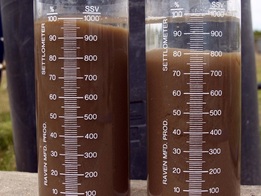 SV30 Test
SV30 Test Today, I am going to relate how settling rates and solids mass tests are related.
SV30
The SV30 is a settling rate test. When mixed liquor is poured into a graduated settling vessel (large graduated cylinder or single purposed SV30 container); it is allowed to settle, undisturbed, for 30 minutes. Some operators record the solids volumes at 5 minute intervals to give a settling rate plot. What we are trying to determine is how well the system is flocculating and what to expect from secondary clarification. In addition to the biomass volume, operators should also note supernatant turbidity and if fines or small floc are floating.
MLVSS or MLSS
Biological solids are measured in a lab procedure to determine the weight of solids. The difference is the MLSS is total solids weight and MLVSS is the volatile fraction of the total solids (usually just biological solids - but can also include fibers and other organic influent solids).
SVI
After getting both the SV30 and the MLVSS numbers, we can calculate the SVI. The purpose of the SVI is to get a standardized number for settling rates. For example a system with an MLVSS of 2,000 should have a lower SV30 than the same system run with a MLVSS of 4,000. To relate settling performance when running different MLVSS numbers, we divide the SV30 number by the MLVSS number (in grams rather than milligrams).
In most system we look for an SVI between <120 ml/g and consider the system bulking with SVI >150 ml/g. If settling happens too quickly as seen with longer sludge ages, you may have pin floc or high turbidity in the supernatant. This is why I like operators to note turbidity and pin floc in the SV30 test.
What do I need to run on a daily basis?
In systems with very uniform operations (little influent variation in flow or makeup), a daily SV30 test with weekly MLVSS checks may be enough for operations. Certain industrial system may require daily MLVSS and 2x daily SV30 tests as influent can change quickly and settling is often the first thing impacted during a spill or upset event. Base your frequency based on the variation that you have seen in the past and since the SV30 is a low cost, simple test - run it on a frequent basis.

 RSS Feed
RSS Feed